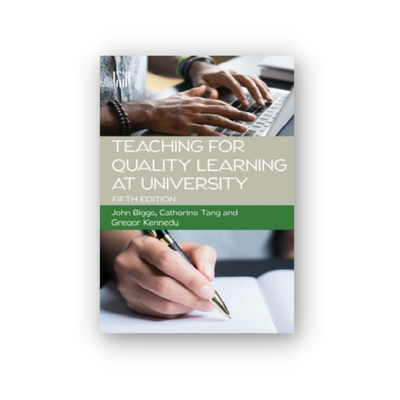Recent Developments in Constructively Aligned Teaching
Recent Developments in Constructively Aligned Teaching
John Biggs, Catherine Tang and Gregor Kennedy
Constructive alignment refers to a way of thinking about how to create or design teaching that is maximally supportive of high-quality learning, and it is used in universities and colleges in many countries around the world. The idea of constructive alignment was first published in 1999 in Teaching for Quality Learning at University and the fourth edition of this book was published in 2011. The fifth edition has just been published by Open University Press/McGraw Hill, and in addition to the original conceivers and authors, John Biggs and Catherine Tang, the latest edition includes Gregor Kennedy.
The basics of constructive alignment
In constructively aligned teaching the focus is on what the learner is to learn and how well (as distinct from what the teacher does, which is often where people start when they think about education). What the learner is to learn is stated in the intended learning outcomes (ILOs) for a unit or course and teaching/learning activities (TLAs) are designed to support the student in achieving those outcomes. Assessment tasks (ATs) are the third component to be ‘aligned’ and are designed to tell us how well the ILOs have been performed. When ILOs are properly designed – which of course requires that teachers have a clear and communicable idea of what they want their student to learn – teaching methods and assessment typically fall easily into place.
Why use constructively aligned teaching?
There is a range of reasons why it is useful to use constructive alignment as a design principle for teaching and learning:
- There is considerable evidence for the benefits of constructively aligned teaching, as summarised in the fifth edition of Teaching for Quality Learning at University. There is now considerable research evidence that indicates constructively aligned teaching not only produces higher quality learning outcomes, but also, students like it. Students feel that they are being supported in their learning and that the assessment tasks they are faced with are transparent and are fairer than traditional assessments.
- It provides a working structure for teachers to step into that enables them to improve their teaching and students’ learning experiences. Constructive alignment has been used as a staple in academic development programs since it was first published. And while designing and implementing the principles of constructive alignment in a unit or course may require some initial effort, once the ILOs, TLAs and ATs have been set up, they are there for following years – to be updated and fine-tuned, for sure – but providing a quality foundation.
- Administrators more and more require their institutions to adopt constructive alignment across the board. It is routine for committees that oversee academic quality in universities to inquire about or require constructive alignment within their courses and units. Constructive alignment provides an institutional framework for assessing teaching quality and establishing quality assurance, and as such, represents a systemic approach to ensuring quality across the institution.


Updates to the Fifth Edition
It has been over ten years since the last edition of Teaching for Quality Learning at University was published and global higher education has seen profound changes during this time. Higher education has become more internationally focussed, the student population has become more diverse, and digital technologies are now deeply embedded in university life, including in its teaching, learning and assessment. And over the last three years universities have had to deal with the incredible disruption and distress of a worldwide pandemic; the lasting impacts of which are still unclear. The 5th Edition of Teaching for Quality Learning at University acknowledges this changed context and considers how constructive alignment can be newly applied within. Particular attention is given to advances in educational technology and how the principles of constructive alignment can be interwoven with best practice principles of learning design in educational technology environments.
While it is inevitable that the global context of higher education and practices within universities themselves will change, it is gratifying that the principles and value of constructive alignment endure.


